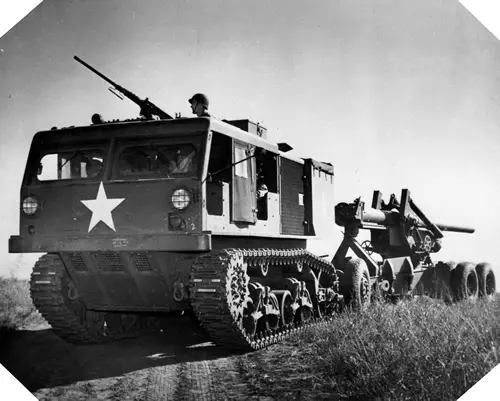M4 High-Speed Tractor
History, technical sheet and photo

M4 Tractor history
The Great War showed the importance of the mobility of the artillery and the nations equip themselves before the Second World War of vehicles charged to replace the horses to move the pieces on the battlefield.
The Americans were equipped late in an all-terrain vehicle capable of towing the heaviest guns on all the different maneuver spaces and in all weather conditions: the Allis-Chalmers company in 1942 offers a tracked mobility vehicle built From the chassis of the aging M2 light tank.
Engaged in the artillery units from 1943 onwards, it consisted of a large caterpillar cabin, sheltering the crew of the tractor at the front and the servants of the towed artillery ‘To eleven personal), with room for additional equipment. Its crossing capabilities allow it to progress on land movements at thirty percent slope.
Deployed on many fronts and especially in Normandy during Operation Overlord and during the subsequent fighting, the M4 Tractor was used by the US Army until 1960. Several versions were developed like the M4C, The servants compartment accommodates additional ammunition.
The M4 Tractor is also used in other armies after the Second World War like Brazil, Greece or the Netherlands.
A more powerful version, the M6, is also produced by Allis-Chalmers. Motorized by two coupled Waukesha, it allows to tow pieces of artillery up to thirty-eight tons.
M4 Tractor specification
Creator/User: United States of America
Denomination: M4 High-Speed Tractor
Number built: 5,000
Length: 5,23 m
Width: 2,46 m
Height: 2,51 m
Weight: 14,288 kg
Maximum speed: 53 km/h
Operational range: 290 km
Armament: one 12,7 mm Browning machine gun
Powerplant: Waukesha 145GZ – 6-cylinder, four-stroke, overhead valves, 190 hp (156 kW) at 2,100 rpm, 13,395 cc
Crew: 1 driver
Transport capacity : 11 artillerymen
![]() Back to the Battle of Normandy vehicles menu
Back to the Battle of Normandy vehicles menu
